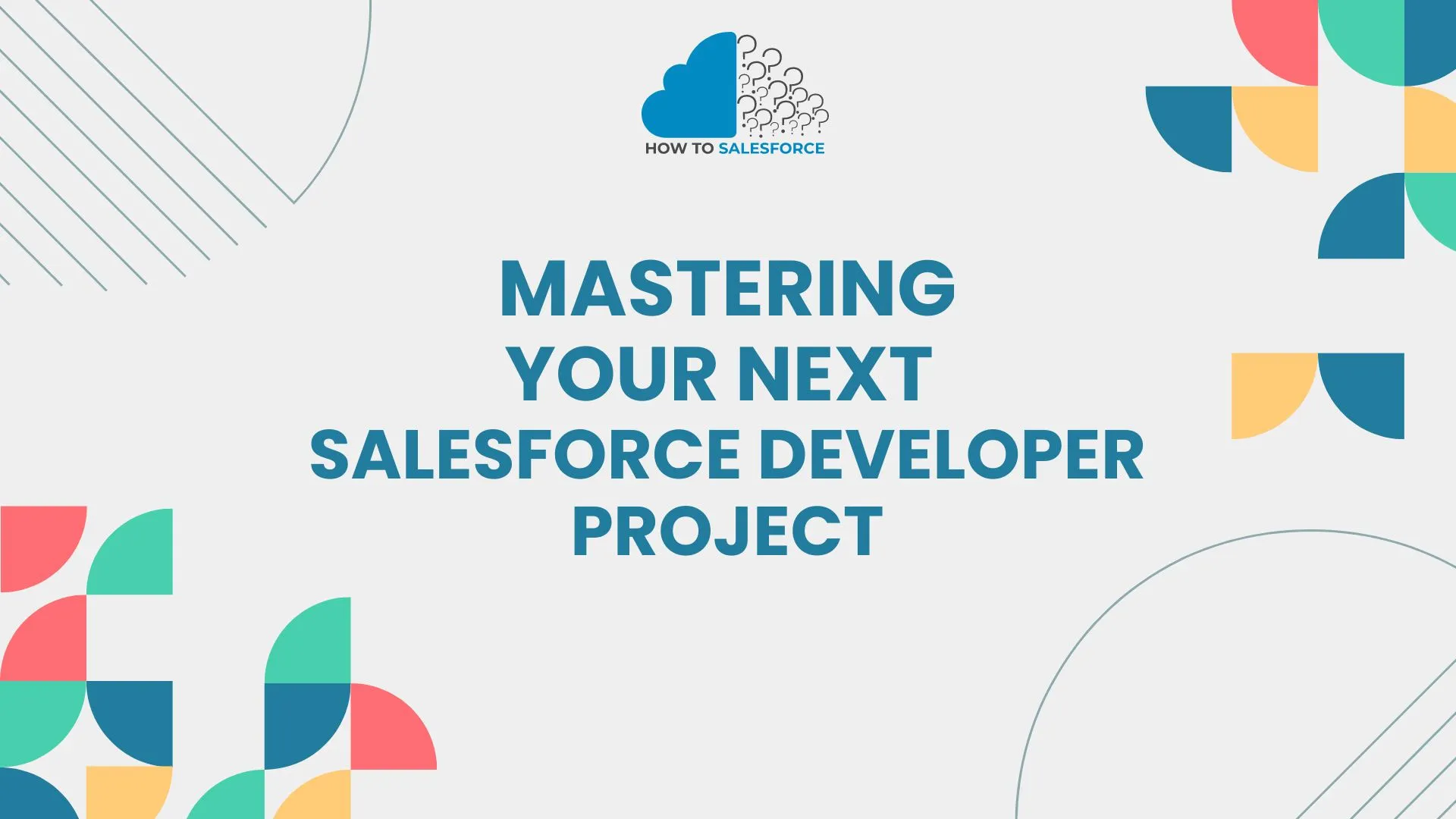Introduction
Taking part in a Salesforce development project can be a very important learning experience that gives you both chances and challenges to show off your technical skills. This blog talks about every part of a Salesforce developer project, from planning and delivery to important factors and best practices in the field.
Do you really want to know about Will AI Replace Salesforce Developers?, Read my article.
Recognizing a Salesforce Developer’s Function
A Salesforce Developer: What Is It?
As a Salesforce developer, your job is to change the Salesforce technology to meet the needs of your business. As part of this job, you will create your own apps, connect third-party systems, automate business processes, and make sure the Salesforce setting works right.
Principal Accountabilities:
- Custom Development: Creating unique applications with Apex, Visualforce, and Lightning Components.
- Integration: Using APIs, Salesforce is connected to other systems.
- Data Management: Taking steps to secure data and guaranteeing its integrity.
- Automation: Creating workflows that are automated to optimize business operations.
- User Interface: The task at hand involves creating and executing interfaces that are easy to use for users.
Salesforce Developer Projects’ Significance
Salesforce developer programs are important to the digital evolution of many businesses. These projects use Salesforce’s powerful features to help companies connect with customers better, make processes more efficient, and encourage growth.
Why It Matters: These Projects:
- Tailored Solutions: Projects give companies the chance to design solutions that precisely match their own procedures and objectives.
- Improved Efficiency: By eliminating manual activities, custom workflows and automations save time and lower mistake rates.
- Enhanced User Experience: Personalized features and interfaces make Salesforce easier to use for both customers and staff.
Organizing Your Project as a Salesforce Developer
Clearly Defined Goals
Before they can start, all Salesforce development projects must have clear goals. Knowing what the company’s goals are will help guide the project and make sure that the end result meets those goals.
Means of Establishing Goals:
- Identify Business Needs: Ascertain the precise issues that the initiative needs to address.
- Define Success Metrics: Establish quantifiable objectives to gauge the project’s effectiveness.
- Align with Stakeholders: Ascertain that the objectives of the project correspond with the expectations of significant stakeholders.
Compiling Conditions
Gathering requirements well is an important part of every Salesforce development project. Part of this step is working with partners to understand their needs and turn them into detailed specs.
Optimal Techniques for Compiling Requirements:
Accurately estimating time and resources is important for keeping the project moving forward. This means figuring out how hard the project is, what skills are needed, and what tools are available.
Estimation Advice:
- Interviews: Talk to stakeholders and end users to learn about their needs.
- Create Use Cases: Outline how the system will be utilized in detail by creating use cases.
- Document Requirements: Maintain thorough records of every need to direct the development process.
Creating the Solution
After describing the needs, the next step is to make the answer. At this stage, a plan is made for how to change the Salesforce platform to meet the project’s objectives.
Important Design Points to Remember:
- Data Model Design: Organize data to facilitate business operations.
- User Interface Design: Create user-friendly interfaces to enhance the user’s experience.
- Integration Points: Arrange the communication between Salesforce and other systems.
Calculating Resources and Time
- Break Down pieces:To more precisely estimate time, divide the job into smaller pieces.
- Assign Resources Wisely: Make sure the appropriate individuals are given assignments that correspond with their skill levels.
- Time buffer: Add buffer time to allow for unforeseen difficulties or delays.
Carrying Out the Salesforce Developer Initiative
Phase of Development
During the development stage, the real work of writing code and setting up things is done. Following the best methods when working on a project makes sure that it can be expanded, kept up to date, and fits the needs of the business.
Principles of Development:
- Version Control: Manage code changes and teamwork with version control systems such as Git.
- Code Reviews: Examine code on a regular basis to make sure it follows best practices and is of high quality.
- Modular Development: To facilitate codebase scalability and management, develop in modular components.
Quality Control and Testing
Testing is an important step that makes sure the project works as planned and meets all the requirements. Both manual and automated testing is necessary to identify and resolve any issues.
Testing Types:
- Unit Testing: Verify that each component functions properly by testing it separately.
- Integration Testing: Verify that various systems and components function as a cohesive unit.
- User Acceptance Testing (UAT): Confirm that the project satisfies user needs and expectations.
Implementation and Live
After all of the testing is done, the project is ready to be put into action. This entails transferring the project from its development location to its intended end user location.
Deployment Procedures:
- The Checklist for Pre-Deployment: Make sure all testing is finished and that any last adjustments are applied.
- Data Migration: Transfer data to Salesforce from current systems if necessary.
- Training: Make sure end users are comfortable utilizing the new system by providing them with training.
- Go-Live Support: Provide assistance to resolve any issues that may come up during the first go-live phase.
Optimal Approaches for Salesforce Developer Initiatives
Using Agile Techniques
The freedom and constant change that the agile method provides are very helpful for Salesforce development projects. By breaking the project up into smaller steps, or rounds, teams can make changes and add value over time.
Best Practices for Agile:
- Daily Stand-Ups: Conduct daily stand-up meetings to monitor advancement and resolve any obstacles.
- Sprint Planning: Arrange the team’s work efficiently such that each iteration has a distinct focus.
- Look Backs: At the conclusion of every sprint, have retrospectives to review the successes and areas for improvement.
Utilizing Best Practices for Salesforce
Developers should follow the best practices that Salesforce gives them to make sure that their projects are safe, reliable, and scalable.
Optimal Procedures for Salesforce
- Use of Standard Objects: Whenever feasible, create custom objects rather than using Salesforce’s standard ones.
- Security: Establish strong security protocols, such as authorization sets, roles, and hierarchies.
- Governor Limits: To prevent performance problems, be aware of Salesforce’s governor limits.
Ongoing Education and Development
The Salesforce environment is constantly evolving with the addition of new features and changes. Deciding to learn new things throughout their lives is important for coders who want to keep up with the latest best practices and technology.
Educational Materials:
- Hint: The free learning platform from Salesforce provides projects and modules to help you develop your abilities.
- Group: Interact with the Salesforce community by participating in events, user groups, and forums.
- Certifications: To demonstrate your expertise, earn Salesforce certifications.
Obstacles in Development Projects for Salesforce
Typical Difficulties
Salesforce software projects have their own set of problems. You can plan ahead and deal with these problems head-on if you know about them.
Principal Difficulties:
- Scope Creep: Monitor changing requirements that may exceed the project’s initial objectives.
- Problems with Integration: It might be difficult to ensure smooth integration between Salesforce and other systems; careful planning is necessary.
- Data Quality: Ensuring the integrity and quality of the data at all times during the project, but particularly when migrating it.
- Performance Optimization: Making sure that as data and users increase, the Salesforce instance maintains its performance.
Overcoming Obstacles
To get around these problems, developers need to be strategic and use their skills to work through difficult project phases.
Successful Strategies:
- Clear Communication: Keep channels of communication open with stakeholders to control expectations and quickly resolve problems.
- Change Management: To handle changing requirements without interfering with the project, put in place a strong change management procedure.
- Regular Testing: To identify and address problems early in the development process, do testing on a regular basis.
- Optimization Techniques: To guarantee that performance is not hampered, apply best practices in database administration and code optimization.
Conclusion
It could be fun and rewarding to work on a Salesforce development project that allows for imagination and new ideas that add value. It is possible to successfully manage the complexities of Salesforce development and execute projects that meet and exceed company objectives by adhering to best practices, remaining flexible, and consistently honing your abilities.
This blog’s tips can help you succeed in Salesforce development jobs, regardless of your experience.


